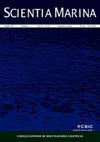海胆(棘皮科:棘皮总科)的物理化学标记方法
IF 0.8
4区 生物学
Q4 MARINE & FRESHWATER BIOLOGY
引用次数: 1
摘要
海胆Paracentrotus lividus(Lamarck,1816)(棘皮动物门:棘皮动物总科)是欧洲的一种重要经济资源,但密集的捕捞导致了几个自然种群的崩溃。与补充库存和提高库存做法相关的刺针接种是解决这个问题的一种替代方案。在这些程序中,通过标记进行可靠的个人识别是一个有价值的信息来源。然而,很少有研究涉及标记方法对P。lividus和海洋无脊椎动物的标记仍然存在几个挑战:生长减少、高死亡率和低标记保留率。在实验室条件下,本研究评估了三种标记方法(无源集成转发器[PIT标签]、编码线标签[CWT]和钙黄绿素)对野生磷的有效性。在总湿重、总增重(mg ind.−1 day−1)、存活率和标签保留率方面,利维杜持续60天。未标记(对照)组的最终总湿重显著高于PIT标记组。PIT标签组、钙黄绿素组和对照组的存活率为100%,CWT组为97%。标签保留率根据标签方法有显著差异:钙黄绿素组为100%,PIT标签组为76.7%,CWT组为38.0%。本文章由计算机程序翻译,如有差异,请以英文原文为准。
Physical and chemical tagging methods for the sea urchin Paracentrotus lividus (Echinodermata: Echinoidea)
The sea urchin Paracentrotus lividus (Lamarck, 1816) (Echinodermata: Echinoidea) is an important economic resource in Europe, but intense harvesting has led to the collapse of several natural populations. Echinoculture, associated with restocking and stock enhancement practices, is an alternative to this problem. In these procedures, reliable individual identification through tagging is a valuable source of information. However, very few studies address the effect of tagging methods on P. lividus and the tagging of marine invertebrates still presents several challenges: decreased growth, high mortality rates and low tag retention rates. Under laboratory conditions, the present study evaluated the effectiveness of three tagging methods (passive integrated transponders [PIT-tags], coded wire tags [CWTs] and calcein) on wild P. lividus for 60 days in terms of total wet weight, total weight gain (mg ind.−1 day−1), survival and tag retention. The final total wet weight was significantly higher in the untagged (control) group than in the PIT-tagged group. Survival rate was 100% for the PIT-tag, calcein and control groups, and 97% for the CWT group. Tag retention differed significantly according to the tagging method: 100% in the calcein group, 76.7% in the PIT-tag group and 38.0% in the CWT group.
求助全文
通过发布文献求助,成功后即可免费获取论文全文。
去求助
来源期刊

Scientia Marina
生物-海洋与淡水生物学
CiteScore
2.10
自引率
0.00%
发文量
21
审稿时长
6-12 weeks
期刊介绍:
Scientia Marina is the successor to Investigación Pesquera, a journal of marine sciences published since 1955 by the Institut de Ciències del Mar de Barcelona (CSIC). Scientia Marina is included in the Science Citation Index since 1998 and publishes original papers, reviews and comments concerning research in the following fields: Marine Biology and Ecology, Fisheries and Fisheries Ecology, Systematics, Faunistics and Marine Biogeography, Physical Oceanography, Chemical Oceanography, and Marine Geology. Emphasis is placed on articles of an interdisciplinary nature and of general interest.
 求助内容:
求助内容: 应助结果提醒方式:
应助结果提醒方式:


